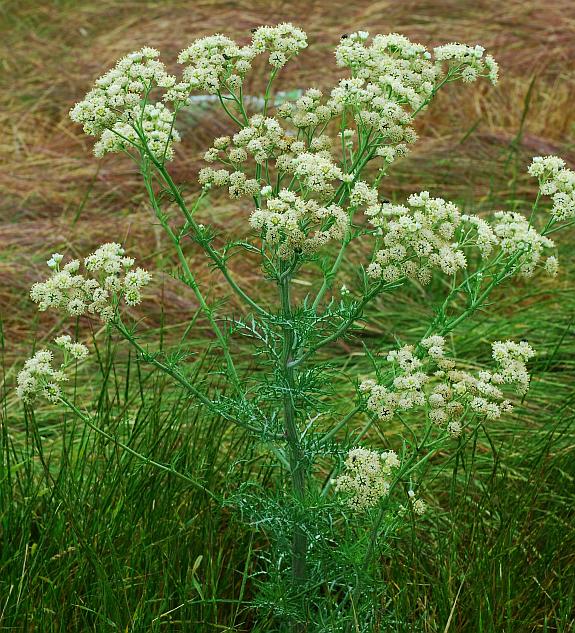Hymenopappus scabiosaeus L'Her.
Old Plainsman

Native
CC = 7
CW =
MOC = 6
© SRTurner
Hymenopappus scabiosaeus L'Her.Old Plainsman | |
 |
Native CC = 7 CW = MOC = 6 |
© SRTurner |
|
Family - Asteraceae/Heliantheae Habit - Taprooted biennial forb. Stem - Ascending to erect, to 1.5 m, usually branched, with several usually relatively conspicuous longitudinal ridges and grooves, moderately to densely pubescent with fine, woolly to cobwebby hairs, often becoming glabrous in patches with age.
Leaves - Basal and alternate, of two kinds: leaves of the first-season basal rosette mostly short- to long-petiolate, the blade 8-25 cm long, oblanceolate to elliptic or lanceolate in outline, 1 or 2 times deeply pinnately lobed (rarely fully compound), the lobes narrowly triangular to narrowly oblong or oblong-elliptic, the upper surface bright green and glabrous or nearly so, the undersurface densely pubescent with white, felty or woolly hairs; basal and stem leaves of the second season short- to long-petiolate, or the median and upper leaves sessile, the blade 2-18 cm long, lanceolate to elliptic or ovate in outline, 1-4 times deeply pinnately lobed, the lobes mostly linear to threadlike, the upper surface bright green and glabrous or nearly so, the undersurface moderately to densely pubescent with white, cobwebby to felty or woolly hairs.
Inflorescence - Flat-topped, open terminal panicles with broad, irregularly shaped, white, membranous bracts at the branch points, the heads usually relatively long-stalked.
Heads - Discoid. Involucre 7-12 mm long, cup-shaped to somewhat bell-shaped, the receptacle 5-9 mm in diameter, the bracts in 2 or 3 subequal series. Involucral bracts 8-14, glabrous or sparsely cobwebby-hairy toward the base and also with minute, sessile glands, green toward the base, white apically to well below the midpoint, those of the outer series ovate to nearly circular, those of the inner series often lanceolate to narrowly elliptic. Receptacle flat or slightly convex, not elongating as the fruits mature, naked, with minute ridges around the attachment points of the florets.
Florets - Ray florets absent. Disc florets 20-60, perfect, the corolla 3.5-5.0 mm long, white to pale cream-colored above the slender, greenish tube, the tube not expanded at the base or persistent at fruiting, glandular-hairy, the abruptly expanded throat and the relatively long lobes mostly with scattered, sessile glands on the outer surface. Style branches with the sterile tip somewhat elongate and tapered to a bluntly pointed tip. Pappus of 14-18 scales, these 0.2-1.0 mm long, obovate, membranous.
Fruits - Achenes 3-5 mm long, more or less obovate to wedge-shaped in outline, somewhat 4-angled, the surface with 8-14 blunt longitudinal ridges, moderately pubescent with fine, more or less spreading hairs, dark brown to black. Flowering - April - July. Habitat - Glades, tops of bluffs, rocky portions of upland prairies, sand prairies, fencerows, cemeteries, and roadsides. Origin - Native to the U.S. Lookalikes - None when flowering. Other info. - This is an uncommon species in Missouri, found in only a few extreme southern counties. It is somewhat more common to our south and west. When in flower the plant is distinctive and unmistakable, with showy whitish flowering heads of a unique appearance. It is unusual and strikingly attractive, and deserving of more widespread cultivation. The flowering heads are scented and attract butterflies. The plants are hardy and drought tolerant. Photographs taken at a rest stop in Foard County, TX, 5-19-2016, and at Sand Prairie Conservation Area, Scott County, MO, 5-6-2020 and 5-29-2020 (SRTurner). |